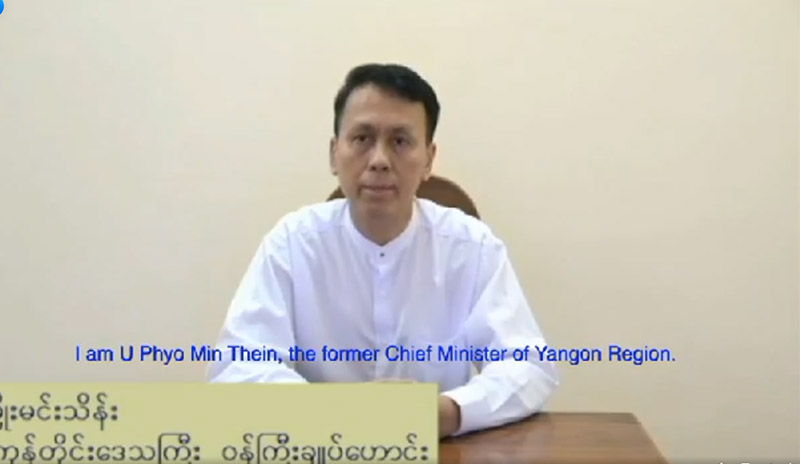Viewers thought there was something off about the latest video confession aired yesterday by military-run media.
When Yangon’s Chief Minister Phyo Min Thein appeared on MRTV to say he bribed deposed State Counselor Aung San Suu Kyi with silk, dollars and gold bars, people saw lips and voices out of synch and worried it was the ultimate disinfo tool: a computer-generated fake to mislead the public.
On social media, many denounced it as “poorly edited,” a “deepfake” and “forged.”
“This video is obviously fake with bad editing skills and it is not U Phyo Min Thein’s voice,” @Khant_htoon tweeted. “This is absolutely lips syncing and his movement is repeating. The Military Terrorists want to spread fake news in technical era but fails.”
In the video, the stone-faced minister makes accusations that have become familiar to viewers in recent days as the military seeks to damage the broad support for Aung San Suu Kyi:
“I went alone to Daw Aung San Suu Kyi’s house three or four times. During the visit, I gave her silk, food, US dollars and gold bars which were put in appropriate shopping bags so as to get support and favr for my works and foundations in the Yangon Region.”
While Phyo Min Thein appears far from natural in the footage, that could also owe to stress and reading from cards. Experts today said the video was more likely a forced “confession” than a deepfake. The screen noise held up online as evidence of editing was more likely a result of the video’s data stream.
“We increasingly think this is more likely to be an actual forced confession, where the small visual artefacts you can see are due to the compression, not to the use of deepfake technology,” said Sam Gregory, director at Witness, a digital human rights nonprofit. “Words are probably being placed in the Chief Minister’s mouth, but it is unlikely they are being placed there digitally.”
🛑 This is more realistic than what they did with the u phyo min thein’s video. Please tell them to make realistic video. Lol. credit video- from tiktok.#WhatisHappeningInMaynmar#Mar23Coup pic.twitter.com/kNPg4RnuoY
— LAL RIN KIMI (@Lalrinkimi2021) March 23, 2021
The video has been shared widely on social media, where some went so far as to run it past tools such as deepware.ai and sensity.ai, which are trained to detect digital deception.
Rights groups including Witness have raised concerns about the use of deepfake technology by those in power. Last year, Witness met with partners in the region, including Myanmar, to discuss ways to tackle threats posed by deepfakes and online disinformation.
Though it is growing more accessible – and convincing – the ability to realistically manipulate audiovisual media is still far from widespread.
The real danger right now comes from those in power harnessing those same doubts to claim legitimate videos, such as footage of rights abuses, are fake, which thus “undermines our ability to discern the truth.”
“Be sceptical of a video that obviously could have been faked or coerced – like this one – but don’t assume that everything is fake since that plays into the hands of people with real coercive, physical power. They’ll start to use it to claim that citizen videos showing their abuses, or videos showing officers admitting war crimes, are fake too,” Gregory said.
The aim of #Myanmar #military showing a video of #Yangon Chief Minister’s “confession” in trying to prove alleged corruption involving #AungSanSuuKyi has certainly backfired as it’s trending on social media with many criticising how badly forged it was #WhatsHappeningInMyanmar https://t.co/wmHzeX9e4t pic.twitter.com/6nx6vXpV1Z
— May Wong (@MayWongCNA) March 23, 2021
“We need to be ready for more experimentation by the Myanmar military in using deceptive videos, and to be ready to think how we quickly counter them with clear information, explaining what is happening,” he continued.
Read more about deepfakes and how to detect them at Witness’ website.
Related
ASSK lawyer rejects accusation in junta-controlled media she took $500,000 cash bribes




